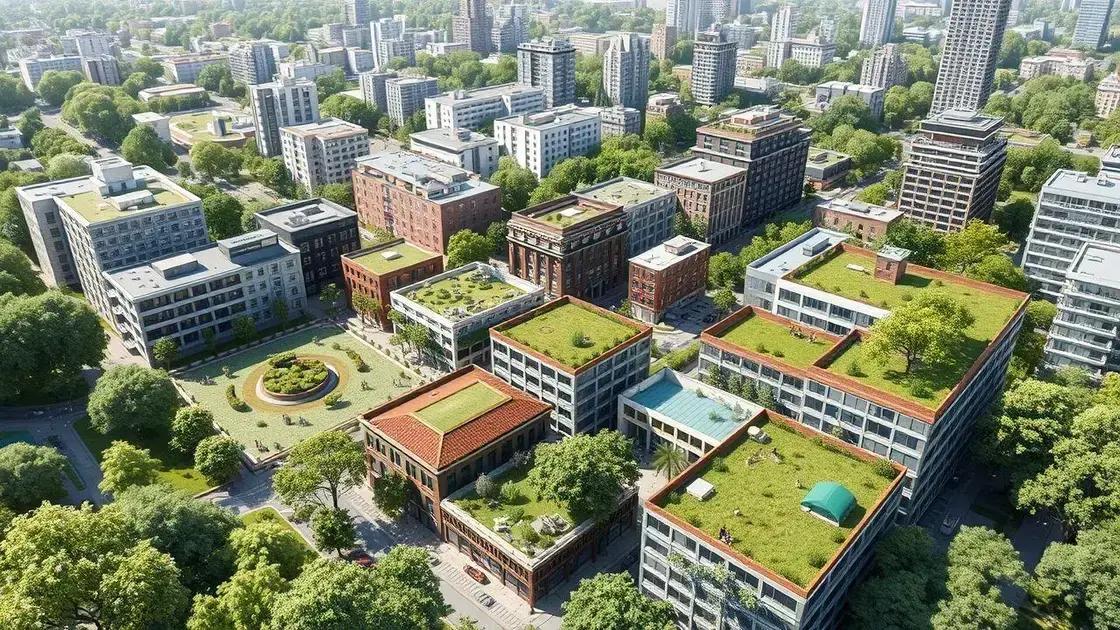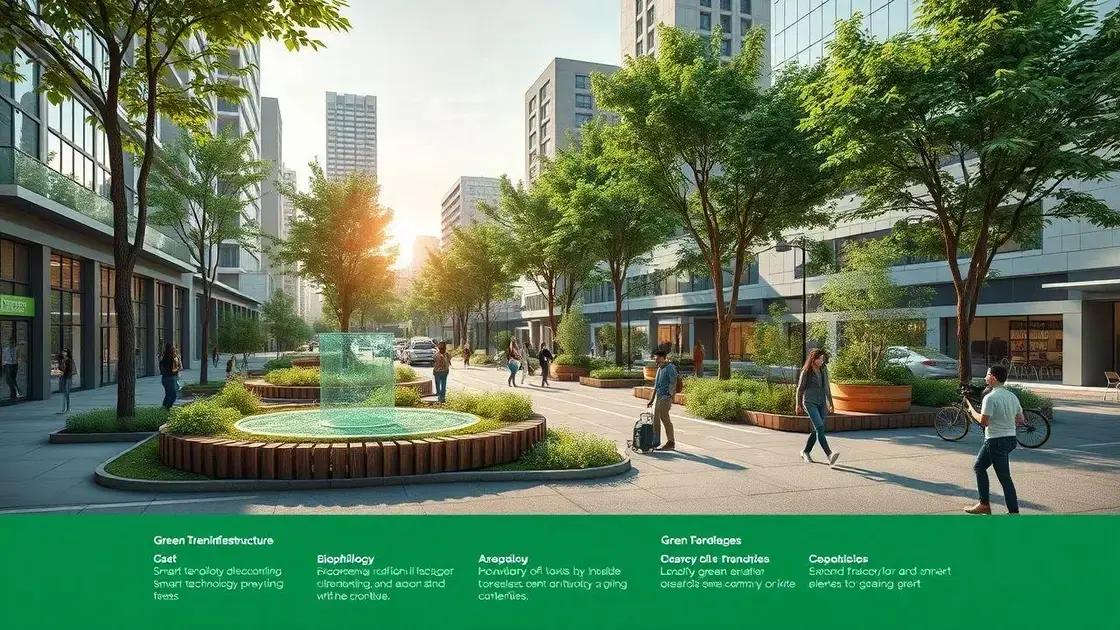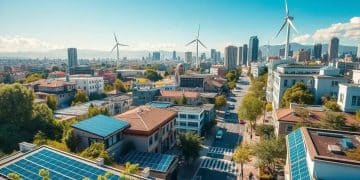Green infrastructure headlines – emerging trend
Green infrastructure involves integrating natural systems into urban settings to enhance sustainability, improve air quality, manage stormwater, and provide social benefits, ultimately making cities more resilient to climate change.
Green infrastructure headlines are gaining traction as cities seek sustainable solutions to pressing environmental issues. Have you noticed how our urban landscapes are evolving? It’s fascinating, isn’t it?
Understanding green infrastructure
Understanding green infrastructure is crucial for modern cities attempting to promote sustainability. This approach combines natural and engineered systems to manage stormwater, improve air quality, and enhance urban aesthetics.
Green infrastructure includes various strategies that utilize natural landscapes to tackle urban challenges. For instance, green roofs can reduce heat, mitigate flooding, and provide habitats for wildlife. By integrating greenery into the urban landscape, cities can transform barren environments into vibrant ecosystems.
Key Elements of Green Infrastructure
Several key elements define green infrastructure:
- Permeable pavements allow water to soak into the ground, reducing runoff.
- Rain gardens are designed to capture and filter stormwater.
- Urban forests provide shade, improve air quality, and support biodiversity.
Awareness of these elements can guide city planners and policymakers in developing effective green infrastructure initiatives. Embracing these innovative solutions not only improves urban living conditions but also contributes to climate resilience.
Integrating Green Infrastructure into Urban Planning
Integrating green infrastructure requires collaboration among various stakeholders, including government agencies, community groups, and private developers. This collaboration ensures that projects meet community needs while addressing environmental impacts.
Educational programs can enhance public understanding of green infrastructure. When people recognize the benefits, they may support initiatives that promote sustainability and health in their neighborhoods. Various cities have already made strides in implementing programs that involve community input and engagement.
As more cities recognize the benefits of combining nature with urban development, we can expect an increase in initiatives that prioritize green areas. The future of urban living may rely heavily on how well we can blend these elements into our daily lives, creating spaces that are not only functional but also enjoyably vibrant.
Benefits of implementing green infrastructure

Implementing green infrastructure offers numerous benefits for urban areas. These advantages span environmental, social, and economic aspects, creating a more sustainable future.
One major benefit is improved stormwater management. Green roofs and rain gardens absorb rainwater, reducing runoff and preventing flooding. This natural absorption helps recharge groundwater and keeps pollutants from entering waterways.
Environmental Benefits
Beyond stormwater management, green infrastructure enhances biodiversity. Plants and green spaces provide habitats for various species. This supports local ecosystems and promotes wildlife presence in urban areas.
Additionally, green infrastructure improves air quality. Trees and vegetation act as natural air filters, absorbing carbon dioxide and releasing oxygen. This creates healthier spaces for residents, reducing respiratory issues caused by pollution.
Social Benefits
The social benefits of green infrastructure are significant as well. Urban parks and green spaces promote community interaction. They encourage physical activities like walking and biking, contributing to healthier lifestyles.
Moreover, environments with abundant greenery are associated with lower stress levels. They create a calming atmosphere that can improve the quality of life for residents. City dwellers often seek refuge in parks for relaxation and recreational activities.
Economic Benefits
Finally, there are economic advantages. Properties near green infrastructure features often see increased values. This makes neighborhoods more attractive to potential buyers and investors.
Moreover, green infrastructure can lead to cost savings for cities. By reducing the need for expensive gray infrastructure developments, such as stormwater treatment plants, cities can allocate resources more efficiently.
Innovative examples of green infrastructure
Exploring innovative examples of green infrastructure can inspire cities to adopt sustainable practices. Many urban areas around the world have successfully integrated green solutions that enhance their environments.
One fantastic example is the use of green roofs. These roofs are designed with vegetation that helps insulate buildings and manage stormwater. Cities like Chicago have led the way in implementing this technology, demonstrating substantial energy savings and reduced heat island effects.
Urban Forests
Another innovative approach is the establishment of urban forests. These forests improve air quality, create wildlife habitats, and provide recreational spaces for residents. New York City has committed to planting trees throughout the city, significantly enhancing urban greenery.
- They cool the environment by providing shade.
- They absorb harmful air pollutants.
- They offer a natural aesthetic, improving neighborhood appeal.
Traffic management also benefits from innovative green infrastructure solutions. Bioretention cells are a brilliant example. These systems filter stormwater while integrating greenery into streetscapes. Cities like Portland have effectively used these cells to beautify their neighborhoods while managing runoff.
Permeable Pavements
Additionally, permeable pavements allow water to filter through surfaces rather than allowing it to run off. This technology helps reduce flooding and can be seen in various city parks and parking lots. By using permeable surfaces in construction, cities can effectively manage stormwater and enhance their green spaces.
Finally, the concept of living walls has gained popularity. These vertical gardens not only promote biodiversity but also improve insulation and air quality. Cities globally, such as Sydney and Paris, have embraced living walls to revitalize urban landscapes.
Future trends in green infrastructure

Future trends in green infrastructure promise to reshape our cities, enhancing sustainability and livability. As urbanization continues, innovative strategies will emerge to address challenges related to climate change and population growth.
One key trend is the integration of technology with green infrastructure. Smart cities are beginning to use sensors and data analytics to monitor green spaces. This technology can help optimize water usage, manage maintenance, and even track ecosystem health. For instance, cities are implementing smart irrigation systems to conserve water while ensuring plant health.
Biophilic Design
Another significant trend is biophilic design. This concept involves creating spaces that connect people to nature. Architects and urban planners are increasingly incorporating natural elements into buildings. Features like indoor gardens and large windows that offer views of greenery enhance well-being in urban settings.
- Living buildings that produce energy and manage waste sustainably.
- Vertical gardens that enhance both aesthetics and air quality.
- Wildlife corridors that connect fragmented habitats in urban areas.
Moreover, cities are recognizing the importance of community involvement in shaping green infrastructure. Engaging residents in planning and maintenance fosters a sense of ownership and responsibility. Programs that promote community gardens and local parks not only beautify neighborhoods but also strengthen community ties.
Resilience Planning
Resilience planning is becoming essential as cities face extreme weather events. Future green infrastructure projects will focus on enhancing resilience against flooding, heatwaves, and storms. Development of wetlands and green spaces can help absorb excess water and mitigate heat effects.
Additionally, with the increasing emphasis on equity, future projects will aim to ensure that all communities benefit from green infrastructure. By prioritizing access to green spaces in underserved neighborhoods, cities can promote social justice and improve public health.
FAQ – Frequently Asked Questions about Green Infrastructure
What is green infrastructure?
Green infrastructure refers to a network of natural and semi-natural systems that provide environmental benefits, such as stormwater management, improved air quality, and habitat for wildlife.
How does green infrastructure benefit cities?
It enhances urban resilience against climate change, improves public health, and increases property values by providing green spaces for recreation and relaxation.
What are some examples of green infrastructure?
Examples include green roofs, rain gardens, urban forests, permeable pavements, and living walls that integrate nature into urban settings.
How can communities participate in green infrastructure projects?
Communities can engage by participating in planning processes, volunteering for maintenance, or creating community gardens, which fosters a sense of ownership and responsibility.





